Not more guff on the Heart
of Gold [HoG for short], surely not! Alas dear reader,
this model is so adaptive I can’t resist hacking it
about. The universal reaction to this model has been one of
revulsion. Too ugly! You can’t be serious? The judges
will hate that!
Well, that’s not what the rulebook has anything to
say about. What the book does require is 5’ radius turns:
these are sharp. I well remember Paul Turner emphasising this:
not many models can actually perform a 5’ radius turn.
There is no requirement for a fuselage, or a cockpit, or a
snappy paint job. Just manoeuvre shapes, with angles and turn
radii.
Part of achieving these stunts is trimming the model. Variables
are wing tip weight, C/G position, lead-out rake, wing asymmetry,
rudder offset, engine side-thrust and differential flap. Some
of these produce yaw, while the others produce roll; all affect
line tension in varying degrees. They can also produce wobble
during the squares.
If the squares are to be made smoothly, then yaw and roll-out
are bad, as they produce wobble. If the trim settings eliminate
yaw and roll-out, then the model must fly fast to maintain
line tension. In fact, the magic figure is in the region of
60 MPH, which is about 4.6 seconds per lap. You need good
reflexes to handle that speed: age and cunning can’t
give you back your youth.
The need for us oldies is to fly slower, say at 50MPH. But
how to stay out on the lines in windy weather; where the line
tension needed for precise shapes?
This predicament has lead to a study, in the first instance,
of engine offset: then, secondly, to a notion concerning the
axis of rotation in squares.
In my experiments with the HoG, I have been able to get
automatic restoration of line tension by offsetting the thrust-line
inboard of the C/G. This is fine for when the lines go slack,
but hey, who wants the lines to go slack in the first place?
How many of you F2B pilots have had the model sag down below
45 degrees in the overhead eights? All of you, my lads, because
your model falls in on you. Not very precise, unless you are
hurtling around like a combat model.
So my thoughts turned to engine offset. Not dainty little
amounts like three degrees. I mean big, manly amounts like
twenty degrees. If we could get a component of engine thrust
pulling the model out on the lines, that would be a nice thing.
So I machined up some side-thrust blocks that stuck the engine
out twelve degrees. That ought to do something.
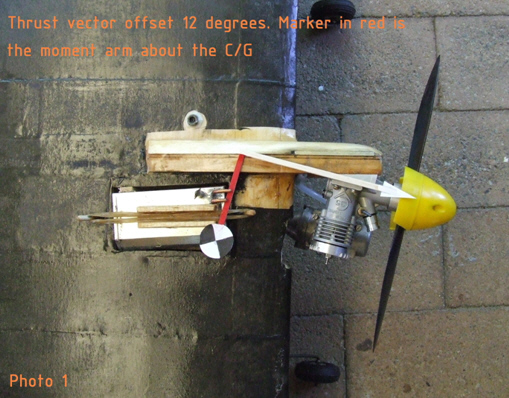
But before I flew this freak, the need to read came over
me. Could I predict what would happen from theory? Well, I
didn’t have a theory, but I did have a book by Toft
and Kersey, “Theory of Machines”, first published
in 1927. That was more like it, a book older than me! Well
there is a chapter headed “Centre of gravity-couple-moment
of inertia etc”
It would appear that if the airplane was going to yaw, it
was going to do it about a vertical axis passing through the
C/G. So far so good. With the thrust-line offset from this
axis, as it is on the HoG by 2”, then there is a yawing
tendency, which is called a “couple”. See photo/diagram
above.
Because the nose is so short, this moment was little changed
by angling the engine out twelve degrees. This twisting couple
is balance by a second couple, produced by the lead-outs,
and acting in the opposite direction.
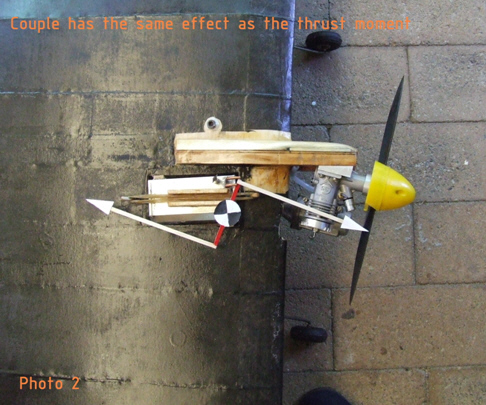
Now something strange happens. According to the “book”,
the couple formed by the thrust-line being offset from the
C/G, can be considered to behave as though the thrust was
actually acting through the C/G, plus the same couple acting
anywhere!
Like I say, weird, but very useful. It meant that my engine
offset of twelve degrees would not increase yaw! This is amazing.
I still have the same couple as with no offset, due to the
geometry, so the yaw should be unchanged!
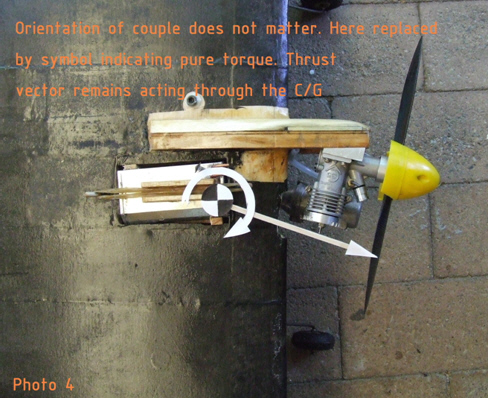
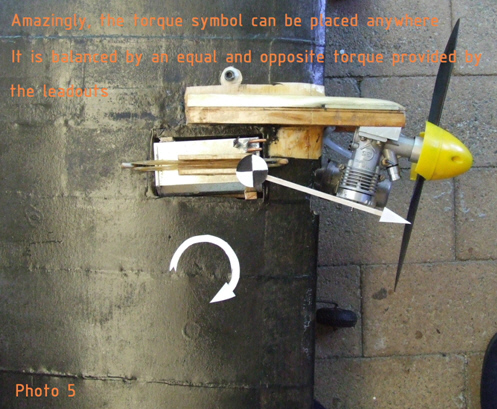
This also meant that I could render the thrust into two components,
one acting to pull the model along, the other increasing line
tension! Now we are getting somewhere!
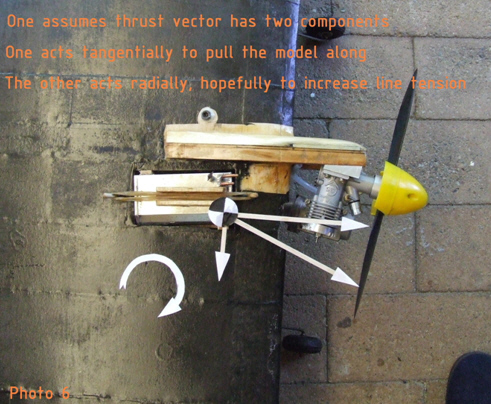
Well I did the necessaries on a Saturday, ready to fly Sunday.
Not to be. The temperature went up to 40 C, the wind blew
a gale till Wednesday, and I got very annoyed with nature.
Fires broke out all over, with flying banned at Whiteman Park
due to the fire risk.
Thursday dawned cool, windless and cloudy: perfect for testing.
So out to Whiteman at 8:00 am, but guess what? The ranger
had not removed the banning notice. By the time we dragged
him out, the clouds were gone, the wind was up, the turbulence
from the trees appalling! My fuel tank is held in with rubber
bands: one day, the turbulence hit so hard that the tank jumped
out of its bay! It was not going to be my day: not totally,
anyway.
The very first flight showed that the theory was right.
The extra twelve degrees of out-thrust had no effect on yaw!
The line tension was increased, but not as much as I had hoped:
certainly not enough to fight the turbulence.
Now for the final act. The model still flew with some yaw,
as set by the raked back lead-outs. I wanted this yaw gone.
My wish was for the model to square about an axis of rotation,
passing through the C/G, parallel to the leading edge, with
an intersection at my control handle. This way, there would
be no wobble during the turn. My choice of this rotation axis
was favoured in the HoG by a uniform distribution of weight
either side of the axis: no wobble due to dynamic unbalance.
Moving the lead-outs forward 1.5” gave zero yaw, as
judged from inside the circle by the alignment of the wheels.
The turn was perfect, no roll (thanks to the correct tip-weight),
no yaw, no wobble, with plenty of line tension due to the
outward thrust component. The turbulence that day prevented
more than just square loops and bunts, but these were encouraging
signs.
However, Saturday came cool with overcast, but with turbulence
from a gusty wind put things to the test. The results were
not good. I was hoping the offset engine would make the model
fly like it was on steel rods. In truth, it was more a case
of Brewers droop. Line tension was OK level, but not maintained
during manoeuvres at 5.6 second laps and 65’ lines.
Very disappointing. Who would have thought the 12 degrees
of offset would do so little?
About the only thing good was the absence of wobble in the
turns. But without good line tension, this was not enough.
So how can one get strong line tension without flying like
a rocket? At the moment, I just don’t know. My only
clue is that regular F2B ships have a big slab-sided fuselage.
Could fuselage lift be a factor? The HoG has no fuselage,
with very little side area compared to a conventional aircraft.
I’ll leave with this thought. Evidently on Youtube
there is video of a large TOC ship losing one wing. Apocryphal
as it may sound, the pilot used his remaining wing to roll
into knife edge, performed the landing pattern, rolled straight
at the last moment and landed!
More work needed.
Comment from Bob:
Line drag: The lines WILL make sort of a catenary curve,
which will result in some sweep back angle as they leave the
plane. One goal of the leadout position is to get the plane
at the right yaw angle given the line sweep back.
The line sweepback is just a function of the line drag (area,
and dynamic pressure distribution along the length of the
lines), plus the line tension (mostly centrifugal force on
the model).
It would be amusing to go figure out the various contributions
to the line tension... centrifugal force, side thrust, body
lift due to current yaw angle (including wind effects). Then
you could go figure out which terms are worth enhancing.
Thrust, per se, probably is a pretty small effect. Thrust
induced yaw moment changing body yaw on a model that can make
some side lift is probably a much bigger term.
|